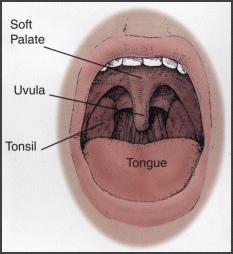Tonsils and adenoids are masses of tissue that are similar to lymph nodes or “glands” found throughout the body, particularly in the neck and armpits. The tonsils are the two masses located in the back of the throat (see Figure 1), while the adenoids are higher in the throat, behind the roof of the mouth (soft palate).
Although their function is not completely understood, most physicians and scientists believe they play a role with the development of the immune system. The location of the tonsils and adenoids allows them to catch and sample incoming germs (viruses and bacteria). The germs are then filtered in the tonsils and adenoids, where an immune response occurs and antibodies are produced. This process allows for strengthening of the overall immune system. This process happens primarily in the first few years of life, becoming less significant as we age. Children who must have their tonsils and adenoids removed suffer no problems with their immune system.
The most common problem affecting the tonsils and adenoids are recurrent infections of the ears, nose, and throat. Patients with tonsillitis have enlarged and reddened tonsils with a white coating, causing symptoms of sore throat, enlarged lymph nodes of the neck, and fever. Adenoiditis is often associated with nasal obstruction (causing the child to breath through their mouth) with a runny nose, bad breath, cough, and fever. Infections of the adenoids can often cause middle ear fluid or infection. These episodes often require antibiotic therapy to clear the infection.
Another common problem caused by tonsils and adenoids is snoring and obstructive sleep apnea. Tonsils and adenoids that are significantly enlarged can cause obstruction, with the main symptom of snoring in pediatric patients. These children often are noted to get “restless” sleep, and may be difficult to get up in the mornings. Adenotonsillectomy surgery is often curative for this in pediatric patients. Adult patients with snoring and sleep apnea, however, are more complex and often tonsil and adenoid surgery alone is not the primary treatment.
Other problems can arise from dysfunctional tonsils. A common problem that occurs in adults is chronic cryptic tonsillitis. These patients develop tonsil stones, known as tonsilloliths, which are a combination of mucous, bacteria, and food particles. Patients often have bad breath, mild trouble swallowing and a chronic sore throat. Other much less common problems arising from the tonsils and adenoids include malignancy, such as lymphoma or carcinoma.
Patients that have recurrent or chronic infections of their tonsils and adenoids that continue despite multiple antibiotics are then treated with surgical removal of the tonsils and adenoids. The surgery is highly successful at reducing the overall number and severity of the infections. Moreover, the same surgery is curative in most pediatric patients with snoring and sleep disordered breathing.
Tonsil and adenoid surgery is often performed on an outpatient basis, taking 45-60 minutes of general anesthesia. Several post-operative symptoms may occur, including throat pain, swallowing problems, ear pain, and fevers. The pain typically lasts 3-5 days in children and up to 7-10 days in adults. I tell patients the surgery causes the worst sore throat pain they will have experienced (but hopefully the last!). There is a small risk of bleeding after the surgery, with most studies demonstrating a 2-4% risk of bleeding. If there is any bleeding noted, the patient should contact the surgeon immediately.
There are more than 10 surgical techniques used to remove the tonsils and adenoids. These different techniques have been compared and studied for many years, in an attempt to determine if one is superior to another. What has been shown is that they are equivocal when comparing postoperative bleeding, meaning there is no definitive evidence that one technique significantly reduces the risk of bleeding after the surgery. The difference in pain following the surgery has shown differences in some studies, but again, there is no significant and consistant results to verify one is better than the other. We are a society that loves technology and new devices, but as far as tonsil and adenoid surgery, the laser or microdebrider or coblator technology has not yet proven better than the other, older techniques. However, this will continue to be studied and I hope that we will soon be able to find technology that will significantly reduce risks of bleeding and pain after the surgery.
Problems from tonsils and adenoids are very common, especially in pediatric patients. However, there are very effective medical and surgical treatments available. Any questions or concerns can be further discussed with your ENT physician.
Figure 1. The tonsils are shown, but the adenoids are not seen as they are located behind the soft palate.
Robert Wilson, MD.

